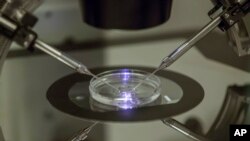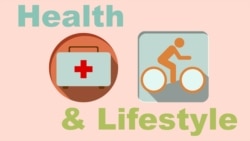For the first time, a new process that uses the genetic material of three people has resulted in the birth of several babies in Britain. The experimental process has been used before in Mexico and the United States.
Britain’s fertility regulator said Wednesday that the parents used a process which was approved with some restrictions in 2015.
The story was first reported by The Guardian newspaper. Britain’s Human Fertilization and Embryology Authority said only that fewer than five babies were born as a result of the process. The treatment is supposed to prevent the babies from inheriting rare genetic diseases.
The treatment of combining DNA from a mother, father and an egg donor is supposed to help women who have a genetic problem that can be passed to their babies.
The problem is in the mitochondria of some women. Mitochondria are parts of some cells in the body that provide energy. However, scientists say the mitochondria in some women can pass genetic problems on to their babies. The genetic defects can cause muscular dystrophy, epilepsy, heart problems and intellectual disabilities. Experts say the genetic problems affect about one in 200 children born in Britain.
So far, 32 patients have been given permission to receive the treatment. The process involves doctors taking genetic material from the mother’s egg and then adding it to a donor’s egg. The donor’s egg has healthy mitochondria, but doctors remove the rest of its important DNA. Doctors fertilize the new egg, so it becomes an embryo and they put it into the mother’s womb.
Scientists say using this process results in the new embryo having less than one percent of the genetic material from the egg’s donor. Scientists at England’s Newcastle University supervised the treatment.
The Human Fertilization and Embryology Authority said Tuesday that it was still “early days” of the treatment. But the government body said it hoped the doctors and scientists who worked on the treatment would soon publish more information.
The agency said all women undergoing the treatment must receive approval and must have no other way of preventing disease.
There are many critics of the treatment. They say there are other ways to prevent disease and the treatment has not been fully tested.
Others say this is the first step in creating “designer” babies for parents who want their children to be taller, smarter or have different looks than they do.
Robin Lovell-Badge is a stem cell expert at the Francis Crick Institute, a research center in London. Lovell-Badge said the babies need to be followed well into the future.
“It will be interesting to know,” he said, “how well the technique worked…whether the babies are free of disease and whether there is any risk of them developing problems later in life.”
One group of scientists published research this year expressing concerns that even a small amount of the problematic DNA from the mother could reproduce as the baby develops in the uterus. Lovell-Badge said scientists do not understand exactly why this happens and more work needs to be done.
I’m Dan Friedell.
Dan Friedell adapted this story for Learning English based on a report by the Associated Press.
_________________________________________________________________
Words in This Story
regulator –n. a government official or office that controls a public activity my making and enforcing rules
inherit –v. (biology) to receive genetic material from a parent
intellectual –adj. related to the mind or mental ability
womb –n. a common word for the organ that produces eggs and holds a fetus in women
stem cell –n. a special kind of cell that has the ability to become another kind of cell in the body
uterus –n. (medical) a term for the organ in a woman that holds the baby during pregnancy; womb
________________________________________________________________
We want to hear from you. What do you think about this genetic process? Is it engineering or a safe way to permit women to have healthy babies?
Here is how our comment system works:
- Write your comment in the box.
- Under the box, you can see four images for social media accounts. They are for Disqus, Facebook, Twitter and Google.
- Click on one image and a box appears. Enter the login for your social media account. Or you may create one on the Disqus system. It is the blue circle with “D” on it. It is free.
Each time you return to comment on the Learning English site, you can use your account and see your comments and replies to them. Our comment policy is here.












Forum